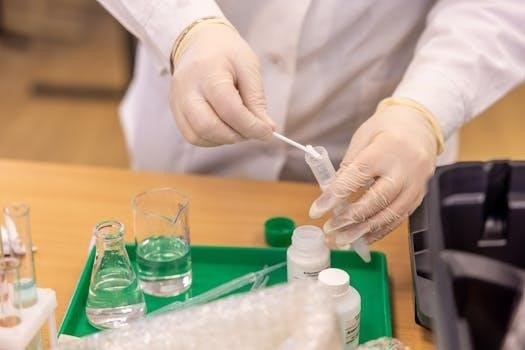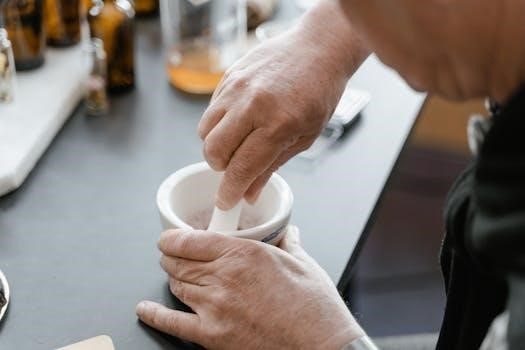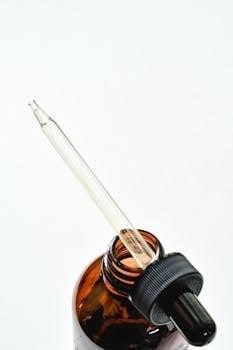This chemistry laboratory manual complements textbooks‚ providing hands-on experience. Mimicking research lab procedures‚ it emphasizes real-world applications of chemistry. It includes experiments designed to follow lecture curriculum. The manual covers basic techniques‚ safety rules‚ and emergency procedures. It also highlights the importance of massing objects accurately. The lab manual guides students through experiments and activities.
Guidelines for Carrying Out Experiments
Before commencing any experiment‚ thoroughly read and understand the instructions provided in the chemistry lab manual. Familiarize yourself with the purpose of the experiment‚ the chemical reactions involved‚ and the expected outcomes. Ensure you have a clear understanding of the procedures and safety precautions.
Gather all necessary materials and equipment as listed in the manual. Double-check the availability and condition of each item. If any equipment is damaged or missing‚ report it to the instructor immediately.
Wear appropriate personal protective equipment (PPE)‚ including a lab coat‚ safety goggles‚ and gloves‚ at all times during the experiment. Ensure the PPE fits properly and provides adequate protection against chemical hazards.
Follow the instructions in the manual precisely. Do not deviate from the prescribed procedures or quantities of chemicals unless instructed by the instructor. Any modifications to the experiment may lead to unexpected results or safety hazards.
Handle chemicals with care and caution. Always use the appropriate dispensing techniques and avoid spills or contamination. If a spill occurs‚ clean it up immediately according to the established safety protocols.
Record all observations and data accurately in your lab notebook. Include details such as the date‚ time‚ experiment title‚ and any relevant notes or comments. Use clear and concise language to describe your findings.
Dispose of chemical waste properly according to the guidelines provided in the manual. Use designated waste containers for different types of waste and avoid mixing incompatible chemicals.
Clean up your work area thoroughly after completing the experiment. Wash all glassware and equipment and return them to their proper storage locations. Wipe down the benchtop and ensure it is free from chemical residue.
Finally‚ review your data and draw conclusions based on your observations. Analyze any errors or discrepancies and discuss them with your instructor. Submit your lab report according to the established deadline.
Lab Rules
Adherence to the following lab rules is mandatory for all individuals working in the chemistry laboratory. These rules are designed to ensure a safe and productive learning environment.
Personal Protective Equipment (PPE)⁚ Lab coats‚ safety goggles‚ and gloves must be worn at all times while in the laboratory. These items provide essential protection against chemical splashes‚ spills‚ and other hazards.
Food and Drink⁚ Eating‚ drinking‚ and chewing gum are strictly prohibited in the laboratory. Chemicals can easily contaminate food and beverages‚ posing a serious health risk.
Horseplay and Distractions⁚ Engaging in horseplay‚ running‚ or causing distractions is not allowed. The laboratory environment requires focus and attention to detail to prevent accidents.
Unauthorized Experiments⁚ Performing unauthorized experiments or deviating from the prescribed procedures is strictly forbidden. All experiments must be approved by the instructor.
Chemical Handling⁚ Handle chemicals with care and respect. Always use the appropriate dispensing techniques and avoid spills. Never return excess chemicals to the original container.
Waste Disposal⁚ Dispose of chemical waste properly according to the designated waste containers. Do not pour chemicals down the drain unless specifically instructed to do so.
Cleanliness⁚ Maintain a clean and organized work area. Clean up spills immediately and wash glassware after use. Return equipment to its proper storage location.
Reporting Accidents⁚ Report all accidents‚ injuries‚ and spills to the instructor immediately‚ regardless of severity.
Emergency Procedures⁚ Familiarize yourself with the location of emergency exits‚ fire extinguishers‚ and first aid kits. Know the proper procedures for responding to fires‚ chemical spills‚ and other emergencies.
Respectful Conduct⁚ Treat all individuals in the laboratory with respect and courtesy. Avoid disruptive behavior and follow the instructions of the instructor.
Lab Safety
Lab safety is paramount in any chemistry laboratory setting. A comprehensive understanding of potential hazards and adherence to safety protocols are crucial for preventing accidents and injuries. The following guidelines outline essential lab safety practices⁚
Personal Protective Equipment (PPE)⁚ Always wear appropriate PPE‚ including safety goggles‚ lab coats‚ and gloves‚ to protect against chemical splashes‚ spills‚ and other hazards. Ensure PPE fits properly and is in good condition.
Chemical Handling⁚ Handle all chemicals with caution and follow instructions carefully. Never mix chemicals unless explicitly directed to do so; Use proper techniques for pouring‚ diluting‚ and transferring chemicals.
Ventilation⁚ Work in well-ventilated areas‚ such as fume hoods‚ when handling volatile or hazardous chemicals. Fume hoods protect laboratory workers by continuously vacuuming air out of the lab.
Awareness of Hazards⁚ Be aware of the potential hazards associated with each chemical and experiment. Consult safety data sheets (SDS) for information on chemical properties‚ hazards‚ and handling precautions.
Emergency Procedures⁚ Know the location of emergency equipment‚ such as fire extinguishers‚ eyewash stations‚ and safety showers. Understand the procedures for responding to fires‚ chemical spills‚ and other emergencies.
Housekeeping⁚ Maintain a clean and organized work area. Clean up spills immediately and dispose of waste properly. Return equipment and chemicals to their designated storage locations.
Proper Waste Disposal⁚ Dispose of chemical waste according to established protocols. Separate waste streams and use appropriate containers for different types of waste.
Unattended Experiments⁚ Never leave experiments unattended unless specifically authorized to do so. If necessary‚ inform a colleague or instructor.
Reporting Incidents⁚ Report all accidents‚ injuries‚ and near misses to the instructor immediately‚ regardless of severity.
General Awareness⁚ Pay attention to your surroundings and be aware of the actions of others in the laboratory. Stay focused and avoid distractions.
First Aid & Emergency Measures
In the event of an accident or emergency in the chemistry laboratory‚ prompt and appropriate action is crucial to minimize harm and ensure safety. Familiarize yourself with the following first aid and emergency measures⁚
Chemical Exposure to Skin⁚ Immediately flush the affected area with copious amounts of water for at least 15 minutes. Remove contaminated clothing while flushing. Seek medical attention if irritation persists or if the chemical is known to be highly corrosive or toxic.
Chemical Exposure to Eyes⁚ Immediately flush the eyes with water using an eyewash station for at least 15 minutes‚ holding the eyelids open. Seek immediate medical attention.
Inhalation of Toxic Fumes⁚ Move the affected person to fresh air immediately. If breathing is difficult‚ administer oxygen if available. Seek medical attention.
Chemical Ingestion⁚ Do not induce vomiting unless directed to do so by a medical professional or poison control center. Rinse the mouth with water and seek immediate medical attention.
Cuts and Lacerations⁚ Clean the wound thoroughly with soap and water. Apply a sterile bandage. Seek medical attention if the cut is deep or bleeding is profuse.
Burns⁚ Immediately cool the burned area with cold water for at least 15 minutes. Cover the burn with a sterile bandage. Seek medical attention if the burn is severe or covers a large area.
Fire⁚ Activate the fire alarm and evacuate the laboratory. Use a fire extinguisher to put out small fires if you are trained to do so. Do not attempt to extinguish large fires. Call emergency services.
Chemical Spills⁚ Notify the instructor immediately. Contain the spill using appropriate materials‚ such as absorbent pads or spill kits. Clean up the spill following established procedures.
Emergency Contact Information⁚ Keep a list of emergency contact numbers readily available‚ including the instructor’s contact information‚ campus security‚ and local emergency services.
General Chemistry Laboratory Rules
The chemistry laboratory can be a hazardous environment if proper safety procedures are not followed. To ensure the safety of yourself and others‚ it is imperative to adhere to the following general chemistry laboratory rules⁚
Personal Protective Equipment (PPE)⁚ Always wear appropriate PPE‚ including a lab coat‚ safety goggles‚ and gloves‚ at all times while in the laboratory. Ensure that your PPE is in good condition and fits properly.
Eye Protection⁚ Safety goggles must be worn at all times to protect your eyes from chemical splashes‚ fumes‚ and projectiles. Contact lenses should be removed before entering the laboratory.
Dress Code⁚ Wear appropriate clothing that covers your skin to minimize the risk of chemical exposure. Avoid wearing loose clothing‚ jewelry‚ or open-toed shoes.
Food and Drink⁚ Eating‚ drinking‚ and chewing gum are strictly prohibited in the laboratory to prevent accidental ingestion of chemicals.
Chemical Handling⁚ Handle all chemicals with care and respect. Read the label carefully before using any chemical. Never mix chemicals unless explicitly instructed to do so;
Waste Disposal⁚ Dispose of chemical waste properly according to established procedures. Do not pour chemicals down the drain unless specifically instructed to do so.
Housekeeping⁚ Keep your work area clean and organized. Clean up spills immediately and dispose of waste properly.
Unauthorized Experiments⁚ Do not perform any unauthorized experiments or deviate from the prescribed procedures.
Reporting Accidents⁚ Report any accidents‚ injuries‚ or spills to the instructor immediately.
Familiarize Yourself⁚ Be aware of the location of safety equipment‚ such as fire extinguishers‚ eyewash stations‚ and safety showers.
The Importance of Massing Objects
In the realm of chemistry‚ the accurate massing of objects stands as a cornerstone of experimental precision and reliable results. Chemistry‚ being an exact science‚ demands meticulous measurements‚ and massing is often the first and most fundamental step in any quantitative analysis. The mass of a substance serves as the foundation for calculating moles‚ concentrations‚ and reaction yields‚ all of which are essential for understanding chemical processes.
Accurate mass measurements are crucial for preparing solutions with specific concentrations. Whether it’s a standard solution for titration or a reagent for a synthesis‚ the mass of the solute directly determines the concentration of the solution. Errors in massing will propagate through subsequent calculations‚ leading to inaccurate results and potentially invalidating the experiment.
Furthermore‚ massing plays a vital role in stoichiometry‚ the study of the quantitative relationships between reactants and products in chemical reactions. By accurately determining the masses of reactants and products‚ chemists can verify the stoichiometry of a reaction‚ calculate theoretical yields‚ and determine the limiting reactant. This information is critical for optimizing reaction conditions and understanding the efficiency of a chemical process.
In gravimetric analysis‚ the mass of a precipitate is used to determine the amount of a specific analyte in a sample. The accuracy of the mass measurement directly impacts the accuracy of the analyte determination. Therefore‚ meticulous attention to detail and proper use of analytical balances are essential for obtaining reliable results.
Fume Hoods and Chemical Reactions
Fume hoods are indispensable pieces of equipment in any chemistry laboratory‚ playing a crucial role in protecting laboratory personnel from hazardous fumes‚ vapors‚ and dust generated during chemical reactions. These ventilated enclosures are designed to capture and exhaust airborne contaminants‚ preventing them from entering the breathing zone of the user and contaminating the lab environment.
During chemical reactions‚ especially those involving volatile or toxic substances‚ the release of fumes is a common occurrence. These fumes can pose significant health risks‚ including respiratory irritation‚ chemical burns‚ and even long-term health problems. Fume hoods effectively mitigate these risks by drawing the contaminated air away from the user and expelling it through a filtration system or directly into the atmosphere‚ ensuring a safe working environment.
The effectiveness of a fume hood depends on several factors‚ including the airflow rate‚ the hood’s design‚ and the user’s work practices. Proper airflow is essential for capturing and removing contaminants‚ while the hood’s design should minimize turbulence and prevent the escape of fumes. Users should always work at least six inches inside the hood to ensure that fumes are effectively contained and exhausted.
Fume hoods are particularly important when working with flammable or explosive materials. By preventing the accumulation of flammable vapors‚ fume hoods reduce the risk of fire or explosion; Additionally‚ fume hoods can provide a physical barrier between the reaction and the user‚ minimizing the potential for splashes or spills to cause injury.
Chemistry Practical Labs⁚ Equipment and Facilities
Chemistry practical labs are indispensable for hands-on learning and experimentation. These labs must be well-equipped and maintained to provide a safe and effective environment for students. Essential equipment includes glassware such as beakers‚ flasks‚ test tubes‚ and burettes‚ which are fundamental for conducting experiments. Measuring tools like balances‚ graduated cylinders‚ and pipettes ensure accurate measurements of mass and volume.
Heating equipment‚ such as Bunsen burners‚ hot plates‚ and heating mantles‚ are crucial for reactions requiring heat. Stirring devices‚ including magnetic stirrers and stirring rods‚ ensure thorough mixing of solutions. Spectrophotometers and other analytical instruments are necessary for analyzing chemical compounds and reactions. Safety equipment like fume hoods‚ safety goggles‚ gloves‚ and lab coats are paramount to protect students from hazardous chemicals and reactions.
Adequate ventilation is essential to remove harmful fumes and maintain air quality. Proper waste disposal systems are necessary for the safe handling and disposal of chemical waste. Emergency equipment such as fire extinguishers‚ eye wash stations‚ and safety showers should be readily accessible in case of accidents.
The layout of the lab should be designed to maximize safety and efficiency. Workstations should be spacious and well-organized‚ providing ample room for experiments. Storage areas should be clearly labeled and organized to ensure easy access to chemicals and equipment. Regular maintenance and inspection of equipment are essential to ensure proper functioning and safety.

Basic Laboratory Techniques
Mastering basic laboratory techniques is crucial for success in chemistry. These techniques enable accurate and safe experimentation. One fundamental technique is measuring mass using balances. It is essential to calibrate balances regularly and handle chemicals carefully to avoid contamination.
Measuring volume accurately is another critical skill. Graduated cylinders‚ pipettes‚ and burettes are used for this purpose. Always read the meniscus at eye level to minimize parallax errors. Proper technique in titrations involves careful addition of titrant and precise endpoint determination.
Heating and cooling techniques are also essential. Bunsen burners‚ hot plates‚ and heating mantles are used for heating‚ while ice baths and cooling baths are used for cooling. Proper use of fume hoods is necessary when working with volatile or hazardous chemicals.
Filtration is a technique used to separate solids from liquids. Gravity filtration and vacuum filtration are common methods. Decantation is a simpler method for separating liquids from solids by carefully pouring off the liquid.
Distillation is used to separate liquids with different boiling points. Simple distillation and fractional distillation are common techniques. Extraction is used to separate compounds based on their solubility in different solvents.
Crystallization is a technique for purifying solids. Dissolving the solid in a hot solvent and then cooling the solution allows crystals to form. Proper drying techniques are essential to remove residual solvent from the crystals.
Finally‚ proper handling and disposal of chemicals are paramount for safety and environmental protection. Always follow safety guidelines and dispose of waste properly. By mastering these basic laboratory techniques‚ students can conduct experiments safely and accurately‚ paving the way for success in chemistry.
Fire Hazard Procedures
Understanding and adhering to fire hazard procedures is paramount in any chemistry laboratory. Fires can occur due to various reasons‚ including flammable chemicals‚ faulty equipment‚ or human error. Being prepared and knowing how to respond can minimize damage and prevent injuries.

The first step in fire safety is prevention. Always store flammable materials in designated safety cabinets. Ensure that flammable liquids are kept away from open flames and heat sources. Regularly inspect electrical equipment for frayed cords or other damage.
In the event of a fire‚ the first priority is to alert everyone in the laboratory. Shout “Fire!” to warn others and activate the nearest fire alarm. Immediately notify the instructor or supervisor of the situation.
If the fire is small and contained‚ use a fire extinguisher to put it out. Remember the PASS acronym⁚ Pull the pin‚ Aim at the base of the fire‚ Squeeze the handle‚ and Sweep from side to side. Ensure the fire extinguisher is the correct type for the fire (e.g.‚ Class B for flammable liquids‚ Class C for electrical fires).

If the fire is large or spreading rapidly‚ evacuate the laboratory immediately. Do not attempt to fight the fire if it is beyond your capabilities. Close doors behind you as you leave to contain the fire and prevent it from spreading.
Once outside‚ gather at a designated assembly point. Ensure that everyone is accounted for and report any missing persons to emergency personnel. Do not re-enter the building until authorized by fire officials.
Regular fire drills should be conducted to familiarize everyone with evacuation procedures. Knowing the location of fire extinguishers‚ fire alarms‚ and emergency exits is crucial for a safe laboratory environment. By following these fire hazard procedures‚ you can help prevent fires and ensure the safety of yourself and others in the laboratory.

